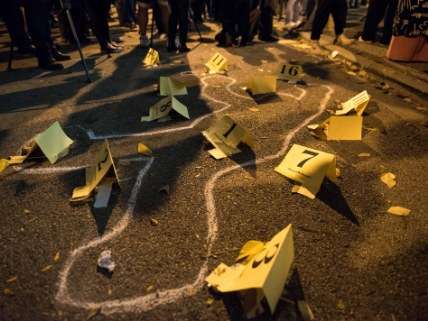Alternatives To Deadly Police Force
Law enforcement has room to make humane changes, without putting their lives in peril.

The man in the Camden, New Jersey, police video is practically begging to be shot. After using a knife to menace a cashier and a customer in a fast-food restaurant, he strides down a street slashing at the air as police repeatedly order him to drop his weapon. The man keeps walking, defiantly waving the knife.
Several cops form a ring around him and move along at a safe distance, block after block. This goes on for several tense minutes, as the viewer waits for shots to ring out. But they never do. Eventually, the man drops the knife and is collared.
It's a reasonably happy outcome. Had the 2015 incident occurred a year earlier, before the department adopted new tactics, "we would more than likely have deployed deadly force and moved on," Chief J. Scott Thomson told The New York Times. Instead, the offender survived, and no cop had to deal with the trauma of killing him.
Camden is not alone in trying a different approach to such confrontations. In Chicago, where 17-year-old Laquan McDonald was shot to death in a similar encounter, the police department has proposed new guidelines on the use of force in the hope of avoiding unnecessary bloodshed. All 12,500 officers are being retrained.
The shift began as the U.S. Justice Department was conducting an investigation that found Chicago police have a "practice of using force, including deadly force, that is unreasonable, in violation of the Fourth Amendment." It also determined that Chicago officers lack "adequate guidance to understand how and when they may use force, or how to safely and effectively control and resolve encounters to reduce the need to use force."
Though reducing the need to use force sounds irreproachable, Attorney General Jeff Sessions takes a dim view of such efforts. He has ordered a review of agreements his department has reached with police departments to curb abuses. But Chicago Mayor Rahm Emanuel and Chicago Police Superintendent Eddie Johnson say they'll implement reforms regardless.
People with knives are a topic of particular importance, as University of California, Berkeley criminologist Franklin Zimring documented in his recent book When Police Kill. Police in America face a far higher risk of being killed on duty than police in Europe—because criminals here are far likelier to have guns. That difference accounts for the far higher rate of fatal shootings of police and by police in this country.
The risk an officer faces of being killed with a knife, by contrast, is the same on both sides of the Atlantic. In a typical year, the number of cops killed with knives in the United States matches the number killed in England and Wales: zero. Criminals kill more police with their hands and feet than with knives.
But people armed with nothing but knives get killed by cops all the time in the United States—as many as 165 times per year, or more than three per week. In England and Wales—where cutting instruments are no less available to criminals than they are here—there were only three fatal shootings of any kind by police from 2011 to 2015.
Police in those places don't kill people bearing knives—and they don't get killed by people bearing knives. They rely on tactics that minimize their use of deadly force without putting their lives in peril. And that is where American law enforcement agencies have room for humane changes.
In this country, a formula known as "the 21-foot rule" has shaped police responses. A 1983 article by a Salt Lake City police instructor said an attacker with a knife could close that distance before an officer could shoot. But the rule has little basis in actual experience. In six years of data, Zimring found no instance in which an assailant with a knife charged an officer and inflicted mortal wounds.
Body armor has made a big difference. But as the Camden episode shows, cops can also protect themselves by staying back, with guns or Tasers in hand, while imploring the person to surrender. A training guide published last year by the Police Executive Research Forum noted that with methods of this kind, police can buy time to build rapport with the subject and get other officers and equipment to the scene to effect a bloodless resolution.
The guide notes that officers sometimes ask how long they should let such encounters go on. The answer: "As long as it takes."
© Copyright 2017 by Creators Syndicate Inc.


Show Comments (28)